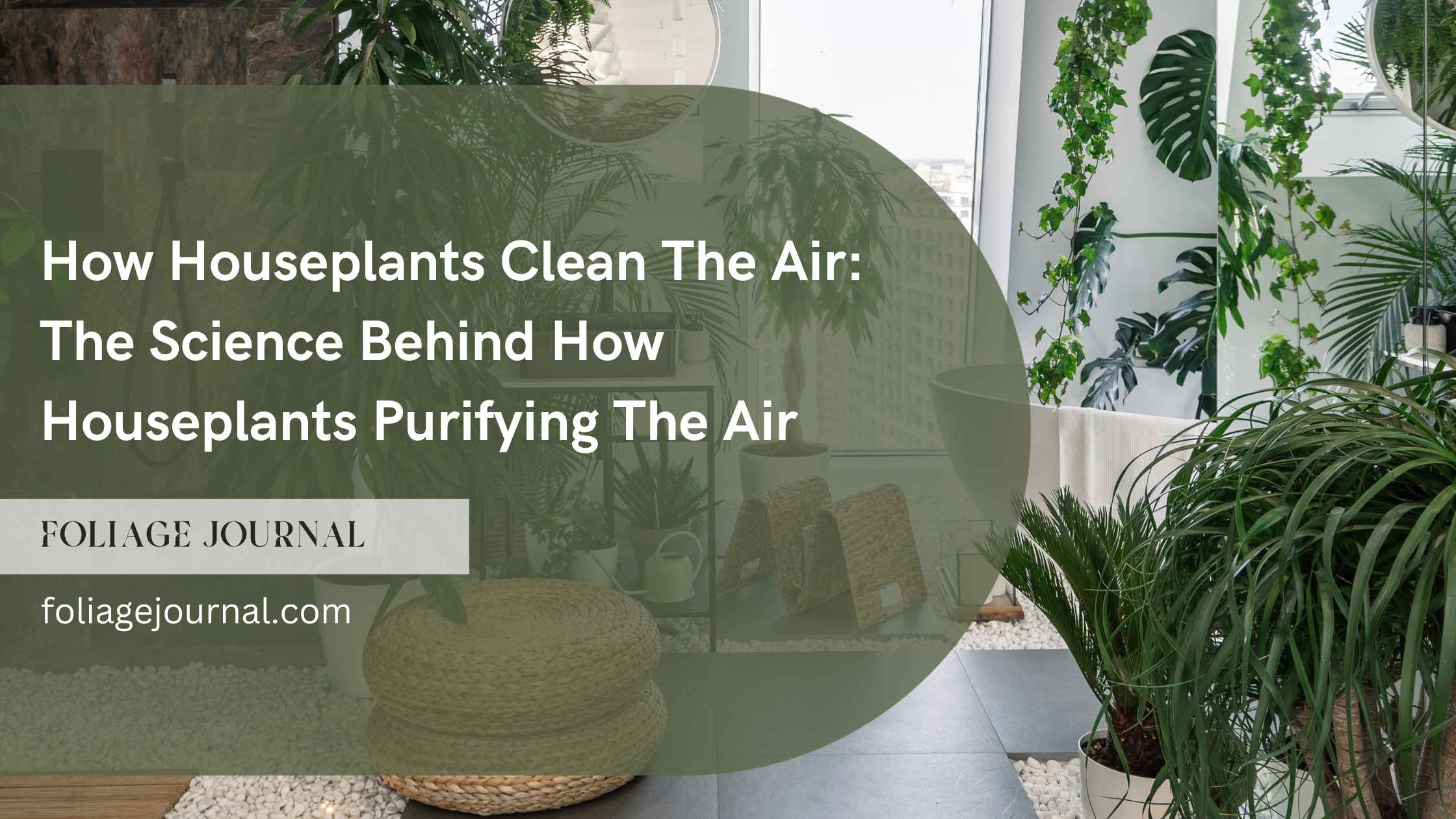Welcome back to my green corner of the internet, where today we’re digging deep into a question I get asked a lot—how do houseplants clean the air? Not only will we explore the science behind this phenomenon, but I’ll also help you pick the best houseplants to improve your home’s air quality. So, grab a cup of herbal tea, and let’s jump in!
Table of Contents
- Intro: The Real Deal on Houseplants and Air Quality
- The Science Behind How Houseplants Clean The Air
- The Role of Activated Carbon in Indoor Planting
- FAQs: Your Burning Questions Answered
Intro: The Real Deal on Houseplants and Air Quality
You’ve probably heard the adage, “Nature is the best healer,” but did you know this wisdom extends to the air we breathe inside our homes? I’m not kidding!
According to the Environmental Protection Agency (EPA), indoor pollutant levels can be two to five times higher than outdoors.
Considering how much time we spend indoors, especially in our current work-from-home era, that’s a pretty big deal!
But how do houseplants clean the air? Is it just a hippy-dippy idea, or is there real science behind it? I assure you, this isn’t a topic to be leafed over lightly (pun absolutely intended).
Indoor air pollution has been linked to various health issues—think headaches, asthma, and even fatigue.
So, sit tight as we uncover how bringing a little green inside can do wonders for your well-being.
In today’s blog, we’ll venture into the realm of scientific explanations, practical tips, and commonly asked questions.
I promise you, by the end of it, you’ll be itching to rush to the nearest nursery, but you’ll also know exactly what to look for. Stick around; you won’t regret it!
The Science Behind How Houseplants Clean The Air
Houseplants have long been celebrated for their aesthetic appeal, but their air-purifying abilities are equally impressive.
Plants don’t just beautify our spaces; they act as living purifiers, working continuously to improve our indoor air quality.
But how does this work? Let’s uncover the science behind this.
| Photosynthesis | Plants take in CO2 through their stomata and use sunlight to convert it into glucose and oxygen. |
| Transpiration | Impacts indoor air quality. As plants absorb water from the soil, they release water vapor from their leaves, thereby increasing indoor humidity levels. |
| Microbiome | Apart from the plant itself, certain microbes can degrade VOCs directly. |
Photosynthesis: More Than Just Plant Food
Carbon Dioxide to Oxygen Conversion: At its core, photosynthesis is a process where plants convert carbon dioxide (CO2) into oxygen.
Plants take in CO2 through their stomata (tiny pores on their leaves) and use sunlight to convert it into glucose (a type of sugar) and oxygen.
This not only sustains the plant but enriches the air with oxygen, which is vital for human respiration.
Toxin Absorption: Beyond the basic CO2 to oxygen transformation, some houseplants can absorb and neutralize specific toxins.
Plants like the spider plant and the peace lily can absorb pollutants like benzene, formaldehyde, and trichloroethylene.
These harmful chemicals are found in everyday items like paints, varnishes, and some cleaning products.
Once the plants absorb these toxins, they transport them to their roots, where they are either stored or transformed into less harmful substances.
Night-time Oxygen Production: It’s worth noting that while most plants take in oxygen and release CO2 at night (a process known as respiration), some, like the snake plant, continue to perform photosynthesis even in the dark.
This makes them especially beneficial for improving indoor air quality around the clock.
Transpiration: The Plant-Powered Humidifier
Moisture Release: Transpiration is a crucial process that impacts indoor air quality. As plants absorb water from the soil, they release water vapor from their leaves, thereby increasing indoor humidity levels.
This is particularly beneficial in environments where the air is dry, as moist air can alleviate dry skin, reduce respiratory irritation, and help maintain respiratory health.
Cooling Effect: Another added benefit of transpiration is its cooling effect.
When water evaporates from a plant’s leaves, it cools the surrounding air. In a way, plants can act as natural air conditioners, helping to moderate indoor temperatures and create a more comfortable environment.
Microbiome Matters: Soil’s Role in Air Purification
Root-Zone Microorganisms: The soil in which plants grow isn’t just a passive medium. It’s teeming with microorganisms that play a role in air purification.
As pollutants are absorbed by the plant and transported to the roots, specific microorganisms in the soil break them down into less harmful substances.
Volatile Organic Compound (VOC) Neutralization: Apart from the plant itself, certain microbes can degrade VOCs directly.
This biodegradation is a biological process where microbes utilize VOCs as a source of carbon and energy.
Through this process, harmful compounds are transformed into harmless products like carbon dioxide and water.
Natural Filtration System: The combination of plant roots and the surrounding soil acts as a natural filtration system.
Together, they not only trap but also degrade various pollutants, ensuring that they don’t accumulate and become a threat to our health.
In summary, the magic of houseplants lies in their holistic approach to air purification. Through photosynthesis, transpiration, and the collaborative effort of root-zone microorganisms, these green wonders actively contribute to healthier indoor environments.
As we understand more about the science behind houseplants, it becomes clear why incorporating them into our living spaces is not just an aesthetic choice but a health-conscious one.
The Role of Activated Carbon in Indoor Planting
Activated carbon, a highly porous form of carbon, has long been recognized for its ability to adsorb a wide range of contaminants.
Its extensive use in water purification and air filtration is testament to its effectiveness. When combined with houseplants, this duo becomes a powerful tool in enhancing indoor air quality.
What Makes Activated Carbon Special?
Porous Structure: One of the main features of activated carbon is its porous nature, which provides a vast surface area for adsorption.
To put it in perspective, a single gram of activated carbon can have a surface area equivalent to several tennis courts!
This allows it to effectively capture various contaminants, including volatile organic compounds (VOCs), odors, and other airborne pollutants.
Chemical Adsorption: Unlike absorption, where materials are taken into the bulk of the absorbent, adsorption refers to the adhesion of atoms, ions, or molecules to a surface.
Activated carbon’s ability to adsorb contaminants arises from its chemical composition and structure, which create an affinity for many pollutants.
Enhancing the Power of Houseplants with Activated Carbon
Dual Filtration: While houseplants can naturally take up and neutralize certain pollutants, introducing activated carbon into the mix enhances this purification process.
While the plant works on absorbing and transforming toxins, the activated carbon captures and holds onto pollutants, ensuring fewer contaminants escape back into the environment.
Protection from Overwatering: An added benefit of using activated carbon in potting mixes is its ability to protect plant roots from rot.
Overwatering can lead to a buildup of harmful chemicals and pathogens in the soil. Activated carbon can help adsorb these excess chemicals, mitigating risks to the plant.
Integrating Activated Carbon in Your Indoor Garden
Choosing the Right Product: It’s essential to opt for activated carbon specifically designed for horticultural use.
This ensures it’s free from added chemicals that could harm plants or further pollute the air.
Application Methods: You can introduce activated carbon to your indoor garden in various ways:
- Mixed with Potting Soil: Blend the activated carbon granules with your regular potting mix. This evenly distributes the carbon throughout, providing consistent adsorption.
- Layering: Placing a layer of activated carbon at the bottom of plant containers can prevent the accumulation of harmful chemicals in the water that collects there.
Maintenance & Replacement: While activated carbon is long-lasting, it doesn’t last forever. Over time, its adsorption sites can become saturated.
Replacing the activated carbon in your pots annually, or whenever you repot your plants, can maintain optimal air purification.
Incorporating activated carbon into your indoor planting regimen elevates the air purification process, making your indoor garden not just a space of aesthetic delight but also a haven of cleaner, fresher air.
Combining nature’s prowess with scientific ingenuity, this synergy offers a holistic approach to indoor well-being.
FAQs
Remember, while houseplants are a fantastic and natural way to enhance indoor air quality, they should be seen as one piece of the puzzle.
Proper ventilation, regular cleaning, and reducing the sources of indoor pollutants are all equally important steps towards creating a healthier indoor environment.

